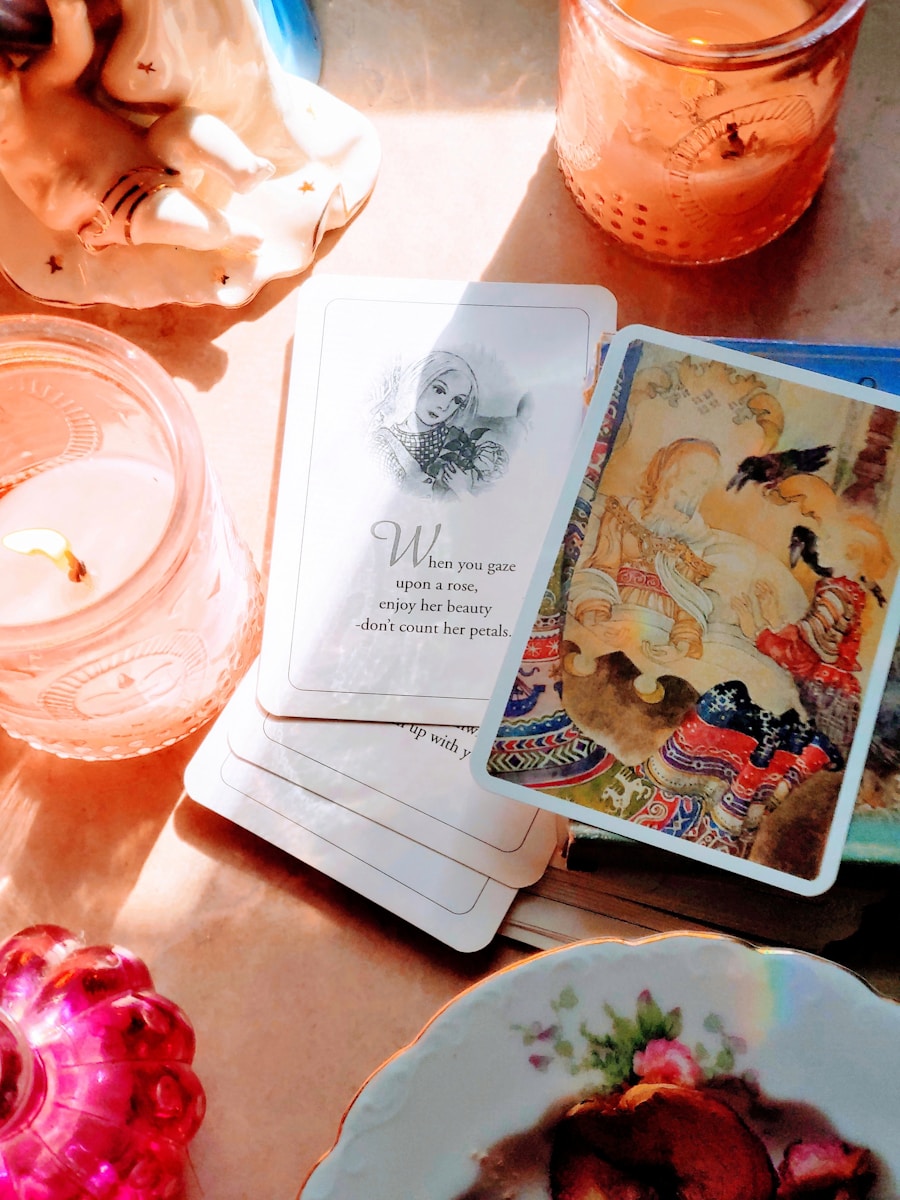
Cleansing your tarot deck is a fundamental practice that many tarot readers consider essential for maintaining the integrity and accuracy of their readings. Over time, tarot cards can absorb energies from their surroundings, including the emotions and intentions of the reader and those they read for. This accumulation of energy can cloud the cards’ messages, leading to readings that may feel off or lack clarity.
By cleansing your deck, you are essentially resetting its energy, allowing it to serve as a clear conduit for intuitive insights and guidance. Moreover, cleansing your tarot deck is not merely about removing negative or stagnant energy; it is also about honoring the cards themselves. Each deck carries its own unique energy and symbolism, and regular cleansing helps to maintain a harmonious relationship between the reader and the cards.
This practice fosters a deeper connection, allowing the reader to tap into the deck’s potential more effectively. Whether you are a seasoned practitioner or a novice, understanding the importance of this ritual can enhance your tarot experience significantly.
Key Takeaways
- Cleansing your tarot deck is important to remove any lingering energy and reset the deck for accurate readings.
- Different methods of cleansing your tarot deck include using smoke, sound, crystals, or visualization techniques.
- It is recommended to cleanse your tarot deck when you first get it, after each reading, and whenever the energy feels off.
- Setting intentions for your tarot deck can help you connect with the cards and enhance the accuracy of your readings.
- Maintaining the energy of your tarot deck involves storing it in a safe and sacred space, and using it regularly to keep the energy flowing.
Different Methods of Cleansing Your Tarot Deck
There are numerous methods for cleansing a tarot deck, each with its own unique approach and benefits. One of the most popular techniques is using smoke from sacred herbs, such as sage or palo santo. The act of wafting smoke over the cards is believed to purify them, dispelling any negative energies that may have accumulated.
This method not only cleanses the cards but also creates a sacred space for readings, enhancing the overall atmosphere. To perform this ritual, one can light the herb, allow it to smolder, and then gently pass each card through the smoke while focusing on the intention of cleansing. Another effective method involves using sound vibrations to clear the energy of the cards.
This can be achieved through singing bowls, bells, or even chanting. The sound waves produced during this process resonate with the cards, breaking up stagnant energy and restoring clarity. To use this method, one can place the deck near the sound source and allow the vibrations to envelop it.
This technique is particularly beneficial for those who are sensitive to energy shifts and prefer a more auditory approach to cleansing. Water is also a powerful element for cleansing tarot decks, although it should be used with caution. Some practitioners choose to lightly sprinkle water over their cards or place them in a bowl of saltwater for a brief period.
However, it is crucial to ensure that the cards are waterproof or that they are dried thoroughly afterward to prevent damage. This method symbolizes purification and renewal, aligning with the natural cycles of life.
When and How Often to Cleanse Your Tarot Deck

The frequency with which you cleanse your tarot deck can vary based on personal preference and usage. Many practitioners recommend cleansing after each reading, especially if the session involved heavy emotional energy or if you read for multiple people in one sitting. This practice ensures that any residual energies do not interfere with future readings, allowing for clearer insights each time you consult your cards.
In addition to cleansing after readings, it is also beneficial to perform a more thorough cleansing at regular intervals—perhaps once a month or during significant lunar phases such as the new moon or full moon. These times are often associated with renewal and reflection, making them ideal for rituals aimed at resetting energies. Additionally, if you feel that your deck has absorbed particularly intense emotions or if you sense a shift in its energy, it may be wise to cleanse it immediately, regardless of your usual schedule.
Setting Intentions for Your Tarot Deck
Setting intentions for your tarot deck is an integral part of establishing a meaningful relationship with your cards. Intentions serve as a guiding force that shapes how you interact with your deck and what you hope to achieve through your readings. When you first acquire a new deck, take time to meditate on what you want from this tool—whether it’s personal growth, clarity in decision-making, or guidance in navigating life’s challenges.
To set intentions effectively, find a quiet space where you can focus without distractions. Hold your deck close to your heart or in your hands, and visualize your intentions as vibrant energy flowing into the cards. You might say affirmations aloud or silently, such as “I intend for this deck to provide me with clear insights” or “I welcome guidance that serves my highest good.” This process not only imbues your deck with purpose but also aligns your energy with that of the cards, creating a synergistic relationship that enhances your readings.
Maintaining the Energy of Your Tarot Deck
Once you have cleansed your tarot deck and set your intentions, maintaining its energy becomes crucial for ongoing accuracy and connection. One effective way to do this is by storing your cards in a dedicated space that feels sacred and protected. Many practitioners choose to keep their decks in silk cloths, wooden boxes, or special pouches that resonate with their personal aesthetic.
This not only protects the cards from physical damage but also creates an energetic boundary that helps preserve their purity. Additionally, regularly engaging with your tarot deck can help maintain its energy. This could involve daily draws where you pull a card for reflection or journaling about your experiences with the cards.
The more you interact with your deck, the more attuned you become to its energy and messages. It’s also beneficial to periodically revisit your intentions and adjust them as needed based on your evolving journey. This ongoing relationship fosters a deeper understanding of both yourself and the insights provided by your tarot cards.
Tips for Accurate Tarot Readings

Achieving accuracy in tarot readings involves more than just having a well-cleansed deck; it requires a combination of intuition, focus, and an understanding of the cards’ meanings. One key tip is to create a conducive environment for readings.
Lighting candles or burning incense can enhance the atmosphere and help you enter a meditative state conducive to intuitive insights. Another important aspect is to trust your intuition during readings. While understanding traditional card meanings is essential, personal interpretations often hold significant weight in providing accurate insights.
Allow yourself to be open to what each card evokes within you—images, feelings, or memories—and let these guide your interpretation rather than relying solely on textbook definitions. Engaging in regular practice will help strengthen this intuitive muscle over time. Lastly, consider keeping a tarot journal where you document your readings, thoughts, and feelings about each session.
This practice not only helps track patterns over time but also allows for reflection on how your interpretations evolve as you grow in your practice. By combining these elements—creating an ideal reading environment, trusting your intuition, and maintaining a reflective journal—you can enhance the accuracy and depth of your tarot readings significantly.
If you are interested in unlocking the secrets of tarot card meanings, you may want to check out this article that delves into the symbolism and interpretations of various cards. Understanding the meanings behind each card can enhance your readings and provide deeper insights into your life. Additionally, learning about the Tower tarot card and its significance in embracing change and transformation, as discussed in this article offers valuable insights into balance, fairness, and accountability in your tarot practice.
FAQs
What is a tarot deck cleansing?
Tarot deck cleansing is the process of removing any negative or stagnant energy from the cards in order to ensure accurate and clear readings.
Why is it important to cleanse your tarot deck?
Cleansing your tarot deck is important because it helps to reset the energy of the cards, allowing for more accurate and insightful readings. It also helps to maintain a strong connection between the reader and the cards.
How often should you cleanse your tarot deck?
The frequency of cleansing your tarot deck can vary depending on how often you use it and the energy it picks up. Some people cleanse their deck after every reading, while others do it on a monthly or quarterly basis.
What are some common methods for cleansing a tarot deck?
Common methods for cleansing a tarot deck include smudging with sage or palo santo, placing the cards in moonlight or sunlight, using crystals, and visualization techniques.
Can you cleanse a tarot deck with water?
It is generally not recommended to cleanse a tarot deck with water, as it can damage the cards. However, some people choose to lightly mist their cards with a water and essential oil spray for cleansing purposes.
How can you tell if your tarot deck needs cleansing?
You may notice that your tarot readings are feeling off or unclear, or that the energy of the cards feels heavy or stagnant. These are signs that your tarot deck may need cleansing.






